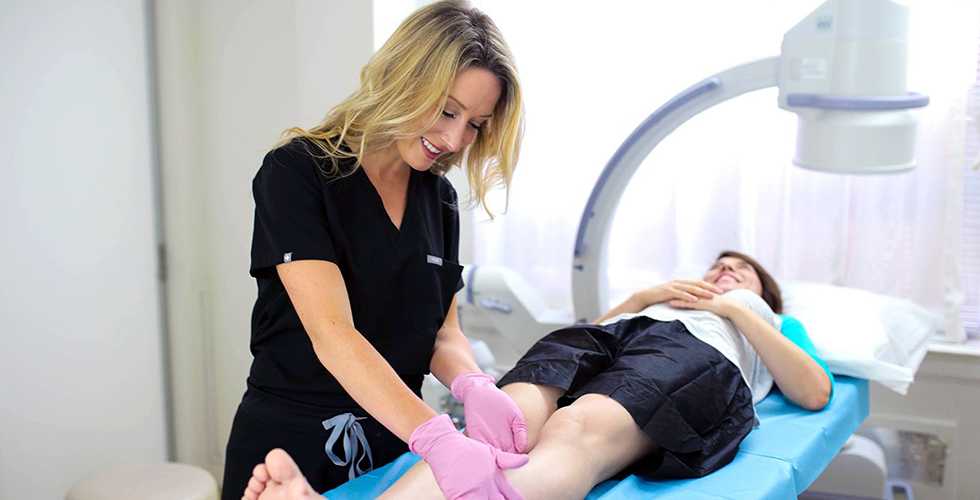If you’ve ever experienced discomfort or pain in your veins, you may be wondering why it happens and what you can do about it. In this article, we will explore the various factors that can lead to vein pain and discuss effective treatment options available at Maryland Vein Clinic. As a leading vein clinic in Silver Spring, Maryland, our board-certified vein doctors specialize in minimally invasive treatments for spider veins and varicose veins.
The Anatomy of Veins
To understand why your veins may hurt, it is crucial to grasp the functioning of veins. Veins are essential blood vessels that play a vital role in carrying deoxygenated blood back to the heart. They are equipped with one-way valves that ensure blood flows in the proper direction, preventing backward flow. However, when these valves become compromised due to damage or weakening, it can give rise to a range of vein-related conditions.

Common Causes of Vein Pain
Varicose Veins
Varicose veins are enlarged and twisted veins. This condition is primarily caused by weakened or damaged valves within the veins, which leads to inefficient blood flow. The increased pressure in the affected veins can cause pain, aching, and a heavy sensation. In addition to discomfort, varicose veins may also result in visible bulging veins, skin discoloration, and even skin ulcers in severe cases. Factors such as genetics, age, obesity, pregnancy, and prolonged standing or sitting can contribute to the development of varicose veins.
Phlebitis
Phlebitis is the inflammation of a vein, typically occurring in the legs. This condition can be caused by various factors, including trauma, injury, or infection. Symptoms of phlebitis include redness, warmth, tenderness, and pain along the affected vein. Superficial phlebitis affects veins close to the surface of the skin, while deep phlebitis, known as deep vein thrombosis (DVT), involves blood clot formation within a deep vein. Prompt diagnosis and treatment of phlebitis are crucial to prevent complications such as blood clot migration or infection.
Thrombophlebitis
Thrombophlebitis occurs when a blood clot forms in a vein, leading to inflammation and pain. This condition can manifest as superficial thrombophlebitis or deep vein thrombosis (DVT). Superficial thrombophlebitis affects veins near the skin’s surface and is often associated with visible redness and a palpable cord-like vein. DVT, on the other hand, involves the formation of a blood clot in a deep vein, typically in the legs. Symptoms of DVT may include swelling, warmth, tenderness, and aching in the affected leg.
Chronic Venous Insufficiency
Chronic venous insufficiency (CVI) occurs when the valves within the veins become damaged or weakened, leading to inadequate blood flow and blood pooling in the lower extremities. CVI results from untreated varicose veins or previous episodes of deep vein thrombosis. Symptoms include aching, swelling, heaviness, and discomfort in the legs. Over time, CVI can cause skin changes, such as skin thickening, discoloration, and venous ulcers. It is important to address CVI promptly to prevent further complications and improve overall vein health.
Other Factors
In addition to the specific conditions mentioned above, vein pain can be caused by various other factors. Damaged valves due to trauma or injury, blood vessel abnormalities, and certain underlying medical conditions like deep vein thrombosis or circulatory disorders can all contribute to vein pain. It is essential to consult with a vein specialist who can perform a comprehensive evaluation to identify the underlying cause of your vein pain and recommend appropriate treatment options tailored to your specific needs.
Accurate Diagnosis of Vein Pain
At Maryland Vein Clinic, we place a strong emphasis on delivering accurate diagnoses to our patients. To achieve this, we employ advanced techniques such as duplex ultrasound. This enables us to thoroughly assess the condition of your veins, identify any abnormalities or underlying issues, and pinpoint the root cause of your vein pain. By gaining a comprehensive understanding of your unique situation, we can create a personalized treatment plan tailored to address your specific needs.
Minimally Invasive Treatments:
- Sclerotherapy: A popular treatment for spider veins, sclerotherapy involves injecting a solution into the affected veins, causing them to collapse and fade over time.
- Endovenous Laser Ablation (EVLA): EVLA uses laser energy to heat and seal off the affected vein, redirecting blood flow to healthier veins.
- Radiofrequency Ablation: Similar to EVLA, radiofrequency ablation utilizes heat generated by radiofrequency energy to close the diseased vein.
- VenaSeal: VenaSeal is a medical adhesive that is used to seal the affected vein, reducing pain and improving blood flow.
- ClariVein: This treatment combines mechanical agitation and medication delivery to close off damaged veins.
- Ambulatory Phlebectomy: Ambulatory phlebectomy involves removing small sections of varicose veins through tiny incisions, promoting better circulation and reducing discomfort.
Prevention and Lifestyle Tips
While treatment options are available, it’s also essential to adopt preventive measures and make lifestyle changes to manage vein health:
- Maintain a healthy weight to reduce pressure on your veins.
- Stay physically active and incorporate exercises that promote good circulation, such as walking or swimming.
- Elevate your legs whenever possible, especially if you sit or stand for extended periods.
- Avoid crossing your legs for long periods, as it can impede blood flow.
- Wear compression stockings as recommended by your vein doctor to support vein function and alleviate symptoms.
Visit Maryland Vein Clinic
Vein pain can be caused by various factors, including varicose veins, phlebitis, and chronic venous insufficiency. At Maryland Vein Clinic, our board-certified vein doctors specialize in accurate diagnosis and provide minimally invasive treatments tailored to your specific needs. Whether you’re dealing with vein pain in your legs, hands, or arms, we help you find relief. Contact us at our Silver Spring location to schedule an appointment and take the first step towards healthier veins and improved well-being. Remember, early intervention is key to preventing further complications and discomfort.






